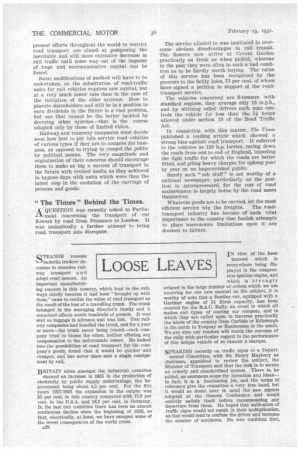Sclerosis of the Traffic Arteries
Page 27

Page 28

If you've noticed an error in this article please click here to report it so we can fix it.
N this country, with its reputation for being comparatively mild and conservative in its treatment of vital questions, the traffic problem is being allowed to sort out itself gradually. The hope of those concerned is doubtless that this process will cause the minimum amount of trouble to themselves and that, eventually, " something may turn up."
In almost every other country the same problem is being faced, but in many eases there is more bitterness in the methods adopted and greater use is being made of the _monopolistic powers that exist. The business man of every nation has awakened to the knowledge that the road is the best traffic artery for shortdistance and, in many cases, for medium-distance hauls. In endeavouring to obtain advantage of the economic benefits offered by the employment of road vehicles he is faced with the selfseeking opposition of those whose livelihood is linked up with rallbound transport, whether it be the ordinary railway or the tramway.
The officials of these fixed-route systems have, by reason of many years of experience prior to the advent of the high-speed road vehicle, grown up with and grown old in methods which sufficed for the needs of days that are past. With increasing age the outlook tends to become fixed and the traffic arteries which they control become less elastic, just in the same way as arises sclerosis of the human arteries. Throughout the world business men demand transport that is as speedy as is commercially attainable, and is more economical in its sphere than systems which, by reason of their essentially high capital cost, cannot be operated at the same favourable rates as the more recently introduced media.
Whilst really long-distance transport may be more cheaply undertaken by large composite units running on rails, the very fixedness of the route precludes its offering to the public that convenience which. plays such an important part in shorter distance work. Whatever the public rightfully wants, in its forward march to better things, it is ultimately bound to get ; history discloses countless examples of this truism.
In the future, however long may be the delay enforced by existing vested Interests, the inexorable law of supply and 'demand will result in that form of transport being .employed which offers the greatest number of practical advantages for any particular set of circumstances.
These facts are so obvious that one cannot imagine that those responsible for railway and tramway systems do not realize their portent. It can therefore be assumed with every justification, that the present efforts throughout the world to restrict road transport are aimed at postponing the inevitable and still more extensive decrease in rail traffic until some way out of the impasse of huge and unremunerative capital can be found.
Basic modifications of method will have to be undertaken, as the substitution a road-traffic units for rail vehicles requires new capital, but at a very much lower rate than in the case of the initiation of the older systems. How to placate shareholders and still be in a position to earn dividends in the future is a vast problem, but one that cannot be the better tackled by decrying other systems—that fs the course adopted only by those of limited vision.
Railway and tramway companies must decide soon how best to put into service road vehicles of various types if they are to compete for business, as opposed to trying to compel the public by political means. The very magnitude and organization of their concerns should encourage them to make as big a success of transport in the future with revised media as they achieved in bygone days with units which were then the latest step in the evolution of the carriage of persons and goods.
"The Times" Behind the Times.
A QUESTION was recently asked in Parlia'tient concerning the transport of cut flowers by road from Penzance to London. It was undoubtedly a further attempt to bring road transport into disrepute. The service alluded to was instituted to overcome obvious disadvantages in rail transit. The flowers -now arrive at Covent Garden practically as fresh as when picked, whereas in the past they were often in such a bad condition as to be hardly worth buying. The value of this service has been recognized by the growers in the Scilly Isles, 75 per cent, of whom have signed a petition in support of the roadtransport service.
The vehicles concerned are 6-tonners With standard engines, they average only 18 m.p.h., and by utilizing relief drivers each man controls the vehicle for less than the 5i hours allowed under section 19 of the• Road Traffic Act.
In connection with this matter, The Times published a leading article which showed a strong bias against road transport. It referred to the vehicles as 120 h.p. lorries, racing down the roads from end to end of England, impeding the light traffic for which the roads are better fitted, and piling heavy charges for upkeep year by year on an impoverished public.
Surely such " sob stuff" is not worthy of a national newspaper, particularly as the position is misrepresented, for the cost of road maintenance is largely borne by the road users themselves.
Whatever goods are to be carried, let the most efficient service win the freights. The roadtransport industry has become of such vital importance to the country that foolish attempts to place uneconomic limitations upon it are doomed to failure.




































































































